
Pine Camp, Jefferson County, NY, July 1924, presents me with a major mystery. I have two photos that were taken there and are clearly marked: Pine Camp, Jefferson C. N.Y. July 1924. They are part of the many unknown photos in my Grandmother’s album that we found hidden in the attic of her home, 35 years after she passed away. (See blog link below.)
The handwriting is not my grandmother’s handwriting. But I think it was her cousin’s Katie’s handwriting, because in many of the photos Grandma and her first cousin are together. Additionally my Grandmother lived with her Aunt’s Family from 1922 until 1925 when she married my grandfather. Grandma and Katie became life-long friends, besides cousins..
I have to think that maybe they were visiting one of Katie’s brothers, she had three. Or perhaps one of four brothers who Katie’s mother helped raise, and later Katie married into that family. But I also have to assume that they knew someone who was there, and who sent them this photo. I cannot imagine that they were allowed to visit them while they were on maneuvers.
Pine Camp was a military site. The New York National Guard trained there in the summer time during the early 1900s. Eventually, during the Second World War, Pine Camp was enlarged and became the training grounds for three divisions of General George S. Patton’s 4th Armored Division. But that happened much latter. It served as a prisoner of war camp and eventually was renamed Camp Drum in 1951.

So who is the person they knew in this picture of six young men? And who is that commanding officer? I have no idea. But perhaps someone can help me solve my military mystery?
Great news! A distant cousin who I connected with several years ago, thanks to help from Tracing the Tribe members, said that one of the men is her great uncle who was Katie’s first husband!!! Thank you!!
New York State Military Museum: https://dmna.ny.gov/forts/fortsM_P/pineCamp.htm





















